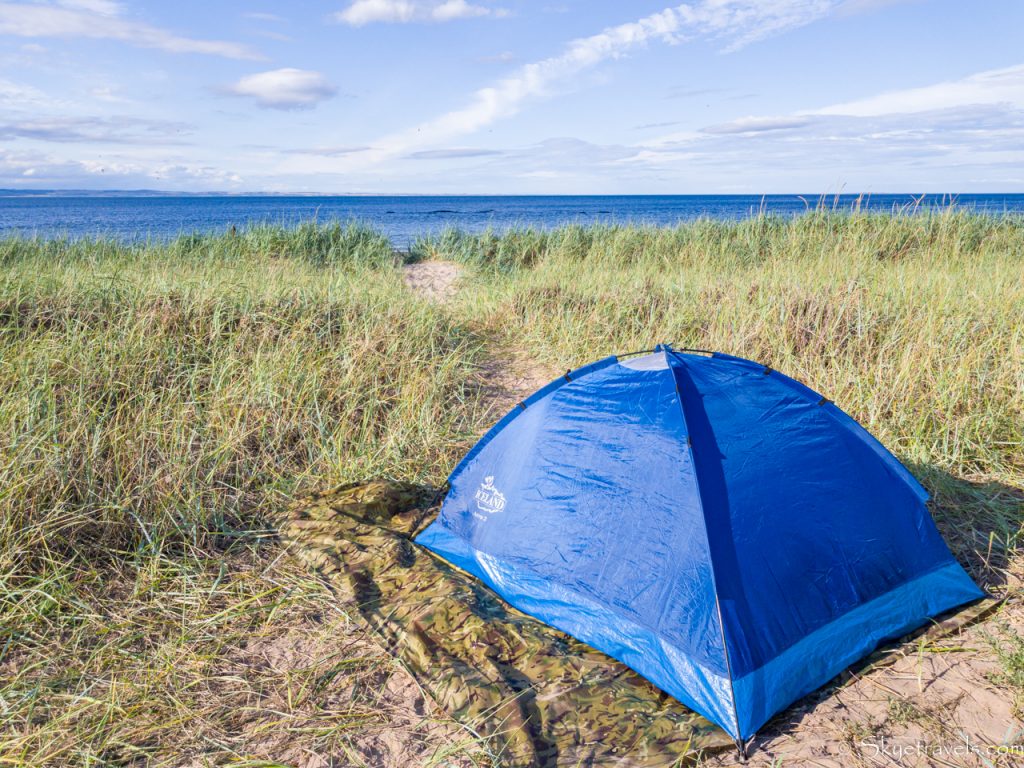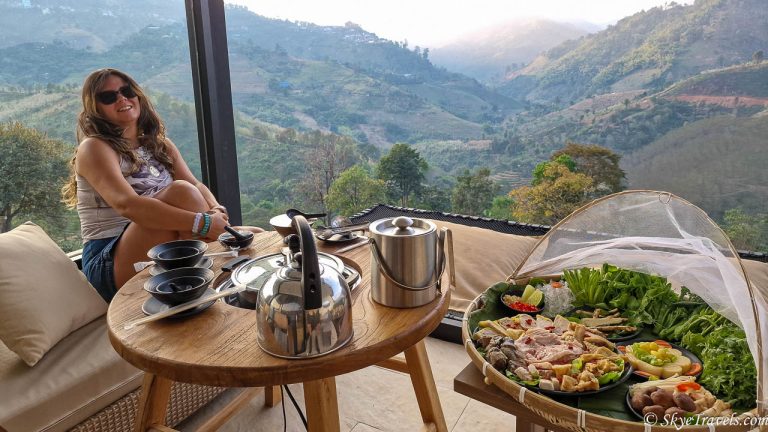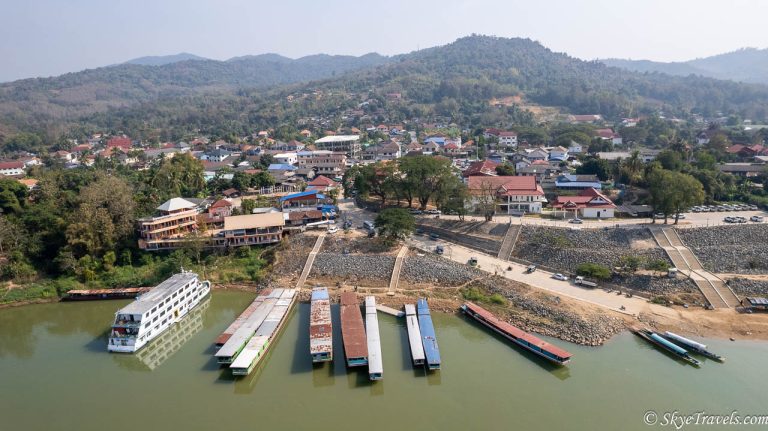I can’t believe it took me five years in an out of Edinburgh to finally go wild camping at Yellowcraig Beach. It’s only an hour away by bus and simply gorgeous! I can see myself going there once a month from now on whenever I’m in town. Here’s why I loved the beach there so much, and what to expect if you go yourself.
Getting to Yellowcraig
Yellowcraig is located only 20 miles east of Edinburgh along the coast, not far from the picturesque holiday village of North Berwick. The beach itself is just over a mile away from the bus stop on the main road. You can reach Yellowcraig with either the 124 or X5 buses – both leaving from Princes Street in Edinburgh’s New Town. You’ll need to get off at Station Road in the village of Dirleton.
From the bus stop, backtrack a few feet in the direction the bus came from and then make right toward the beach. The road is about a mile long to the parking lot, and then it’s just a couple more minutes to the beach.
Not long ago, I wrote an article in an online magazine about the best beaches in Scotland. At that time, I hadn’t been to Yellowcraig. Now I realize I should have totally had this beach on the list, if only for its close proximity to Edinburgh. I did mention Portobello, which is the beach right next to my new home, but Yellowcraig is much better and far less crowded.
Yellowcraig Beach stretches about a mile between two golf courses – Archerfield Links and North Berwick Links, and then continues into Broadsands Beach to the east. Directly out to sea from the beach is the stunning Fidra Island. This island has the ruins of a 12th-century chapel, once had a stronghold called Castle Tarbet, and now the prominent feature is a lighthouse built in 1885. Claims have been made that the map in Robert Lewis Stevenson’s Treasure Island was based on Fidra Island. It’s now a bird reserve, and you can see live camera feeds at the Scottish Seabird Centre in North Berwick.
As with all of the coastline in Scotland, the beach is tidal, and the waters ebb and flow up to 15 feet up and down twice a day. As such, the beach looks completely different throughout the day. At high tide, the water comes quite close to the sand dunes. When the water recedes, the extensive rocks and tide pools become visible. Between the two extremes, there’s about a thousand feet difference where the water reaches.
Wild Camping at Yellowcraig Beach
Locals from Edinburgh and beyond camp all the time at Yellowcraig Beach. For years, people have been pitching their tents directly on the sand, in the sand dunes, in the grassy field between the dunes and the forest, or in the forest itself. In 2022, the local government asked that visitors only pitch their tent along the beach. Vanesa and I stayed in the sand dunes, just a few steps from the sand, giving a small buffer from the wind and a bit of privacy too.
While it’s classified as wild camping at Yellowcraig Beach, it’s far more developed than most wild camping locations across Scotland. At the parking lot (known as a car park in the UK), there are bathrooms which are currently open from 10 a.m. to 6 p.m. There are also rangers routinely patrolling the beach to ensure everyone is following the rules of wild camping (see below) and keeping the beach clean. It only costs £2 ($2.60) per day to park at the parking lot between the hours of 8 a.m. and 6 p.m. Due to current restrictions, overnight parking while wild camping is not permitted.
The night we went, it was Friday on a sunny summer evening and there were about 100 tents set up either on the sand, in the dunes, on the grass or in the forest. The closest tent to us was about 50 feet away – the people on the beach were closer. At night, the beach was filled with campfires every few feet, and a couple also sprang up in the grassy field, although those were technically against the rules.
I brought Polish kielbasa sausages and marshmallows for dinner, but I had yet to replace my camping stove which was stolen earlier this year. Instead, I put the sausages on a couple clean tent stakes and then found a group of students who had built their own fire for marshmallows on the beach. They were happy to let me cook the sausages, and we had a great conversation as we watched a truly epic sunset. We just couldn’t have picked a better night to go camping!
Paddle Boards, Kayaks, Horses and Stunt Pilots
It’s nice to just relax on the sand and perhaps swim a bit…if you don’t mind water that peaks at 15°c (59°f) in August and gets as cold as 5°c (41°f) in the winter. Cold water never stops me, and I had a really nice morning swim while the tide was low. But for those who aren’t brave enough to swim in the cold, open water, there are plenty of other things on the beach to keep an eye out for.
Many people bring out their watercraft – paddleboards, canoes and kayaks. The paddleboards stay around the shore, but some of the canoes go out to explore the islands – Firda close by, and the islands of Lamb and South Dog further out. Craigleith Island and Bass Rock are also visible from Yellowcraig Beach, although much further away.
In the morning, I was thrilled to see horseback riders on the beach. I would have loved to see free-roaming horses but, so far, I’ve only seen them at Luskentyre Beach on the Isle of Lewis and Harris.
Finally, there were the occasional light planes and WWII jets doing tricks out to sea, presumably from the nearby East Fortune Airfield. There were also quite a few motorized gliders flying about, which I’d love to try out myself someday!
Rules for Wildcamping in Scotland
Visit Scotland states: “As part of Scotland’s access legislation, the Land Reform (Scotland) Act 2003, you are allowed to camp on most unenclosed land.” In other words, you can wild camp in many places around Scotland (except around Loch Lomond), but there are quite a few rules and courtesies to observe, as given by Visit Scotland.
- Leave no impression. Anywhere you camp in Scotland, try to leave the area just as you found it.
- Don’t leave any trash or waste.
- Urinate away from water, bury feces underground, and take your toilet paper with you as animals can dig it up. (Sorry to make that crude.)
- If you’re in view of or near a homestead, you should check with them to ensure it’s okay to camp in the spot you picked.
- Don’t make a fire near dry bushes or grass. Build your fire on sand or rocks, or use a barbecue or travel stove in a controlled environment.
- If there are neighbors around (homes or other campers), keep the noise level down when people could be sleeping.
- You cannot stay in the same spot for more than 3 days (2 days for Yellowcraig Beach).
- Wild camping applies to arriving by foot or bike. You shouldn’t bring your vehicle to the spot you’re camping at.
All these rules apply at Yellowcraig Beach. Barbecues and fires are only allowed on the sand of the beach, not in the dunes, the grassy field or the forest. If possible, use the public toilets when they’re open. Make sure to completely clean up after yourself to preserve this beautiful location. I was happy to receive a “well done” by the rangers for keeping my campsite clean and organized.
2022 Updated Guidelines
Due to the huge influx of visitors wild camping at Yellowcraig Beach over the past couple years (I can only imagine I had something to do with that), the local government has asked to the following information and guidelines to be included in this article for all to follow:
Wild camping is:
- Part of a pedestrian or cycled journey.
- Lightweight – every piece of equipment is carried as part of that journey.
- Done in small tents (2 person) and a maximum of four campers together.
- Only for two nights in any one place.
- Done discretely – respecting neighbours and nature.
Further details can be found at: Wild camping | East Lothian Council. They also have Land Management Rules and on-site signage giving directions to those looking to wild camp in particular locations. For example, at Yellowcraig and Whitesands, wild camping should be done on the beach edge only. Fires are discouraged.
We do not permit people to camp in car parks, and our coastal car parks do not permit overnight parking.
Packing for a Night of Wild Camping at Yellowcraig
Obviously, everyone has a different expectation of comfort when it comes to camping. Some people bring massive 4-person tents, inflatable mattresses, a crate of firewood, beach chairs, beach umbrellas, etc. I prefer to go minimalistic, packing only what will fit into my REI Grand Tour 85L backpack or Osprey Farpoint 40. Whatever your style is, there are some essentials to bring with you when wild camping in Scotland.
- Waterproof clothing: It’s almost guaranteed to rain in Scotland; we were exceptionally lucky with our perfect weather while we camped at Yellowcraig Beach. A set of waterproof pants (trousers in British English) and a windbreaker will come in very handy. I recommend products from Craghoppers Outlet which ships internationally.
- Good boots: With the rain comes mud. Even at Yellowcraig Beach where you’ll mostly be walking on sand or grass, there are still muddy patches where you’ll be glad to have proper footwear. Craghoppers Outlet also sells great boots.
- Waterproof tent: My tiny, lightweight tent isn’t exactly proper for Scotland, even though I’ve used it throughout the country including on the West Highland Way. While I do recommend something lightweight for when you’re hiking, it’s a good idea to invest in something a little more durable and waterproof – or get the best of both worlds with a Bessport waterproof, lightweight tent). Alternatively, you can get a tarp to throw over the tent, which is what I use.
- Midge repellent: As I’ve mentioned before, probably the worst thing about Scotland is the midge population. These tiny mosquito-like bugs attack in massive swarms, particularly in the Highlands over the summer. You won’t have to worry about them too much around Yellowcraig, but carrying some Smidge (the local midge repellent) is always a good idea. Personally, I use Avon Skin So Soft, as I get rashes from the DEET in Smidge.
- Barbecue or stove: As mentioned above, you’re allowed to make a fire on sand or rocks, but it’s a much better idea to bring a suspended BBQ (one that doesn’t touch and scorch the ground) or camping stove. I had my own until it was stolen earlier this year, and I didn’t get a chance to replace it before visiting Yellowcraig Beach.
- A proper sleeping bag: This one is really a matter of preference. I personally use the thinnest sleeping bag I could find, and if I ever get cold (which is really rare), I throw on a set of baselayers. If you tend to get cold at night, I’d recommend getting a sleeping bag rated for freezing temperatures.
- Toilet paper, Ziploc bags, and a trowel: Make sure you bring the proper items for going to the bathroom. As a traveler, I’ve always got toilet paper on me, but you can’t leave it on the ground in Scotland. So the Ziploc bags are for the paper and a trowel is for other solid waste. Sanitary wipes are also a good idea if you want to keep things a bit cleaner.
- A power bank: I don’t think I need to tell you to bring your phone, but you should also have an extra power bank in case your phone dies. I recommend an Anker power bank as they’re very reliable (except for that one time when one blew up on me). Other than my phone, I consider my power bank as one of the most valuable possessions in my travels.
Click to Pin It
Further Reading
Looking for other activities in Edinburgh that aren’t necessarily weather-dependent? Here are some other options, as well as some recommendations on where to eat in Edinburgh.
- 5 Amazing Cafes and Restaurants in Edinburgh That I Frequent
- Best Places to Eat in Edinburgh on a Budget
- How to Find the Best Brazilian Crepes in Edinburgh
- The Village Hotel in Edinburgh is So Much More Than a Hotel
- There’s a Cat Cafe in Edinburgh!
- Enjoying the Happiest Place in Scotland at Edinburgh’s Chihuahua Cafe
- Begin Your Journey in Scotland with a Secret Food Tour in Edinburgh
- What the Da Vinci Code Didn’t Show You About Rosslyn Chapel
- Camera Obscura in Edinburgh Brings Out the Kid in You
- Experience the Underground Preservation of Mary King’s Close
- Escape Edinburgh: The Most Fun Activity in Edinburgh’s New Town
- Finding the Best Ghost Tours in Edinburgh
- Riding the Most Delicious Tour in Edinburgh on the Red Bus Bistro
- 9 Free Attractions to Visit in Edinburgh
- 10 Activities for The Perfect Day Trip from Edinburgh
- A Virtual Tour of Holyrood Palace in Edinburgh, Scotland
- 21 Attractions in Edinburgh for a Rainy Day
Here’s some extra reading to save hundreds on your next vacation or stage of your journey.
- 5 Steps to Book Cheap Flights
- Hostels: To Book or Not to Book
- Is Workaway Worth it for the Traveler?
- Click here to claim your $25 credit with AirB&B
This post may contain affiliate links. These links help give me the wherewithal to continue traveling at no additional cost to you. For more information, click here.
























2 Comments
Absolutely love this guide, it’s great and has convinced me to go camping at Yellowcraig! I was just wondering if you knew if there was fresh water facilities there or if the water at the sinks is safe to drink?
You’re going to love it! Honestly one of my favorite camping spots in Southern Scotland. So far, I’ve never hesitated in drinking from any tap in Scotland, but I don’t specifically remember drinking from the tap at Yellowcraig. The only sinks are in the bathrooms by the parking lot.